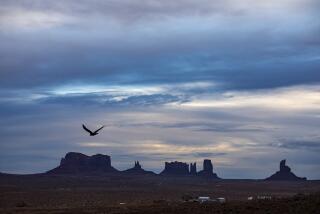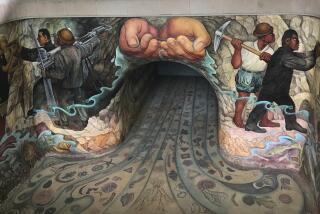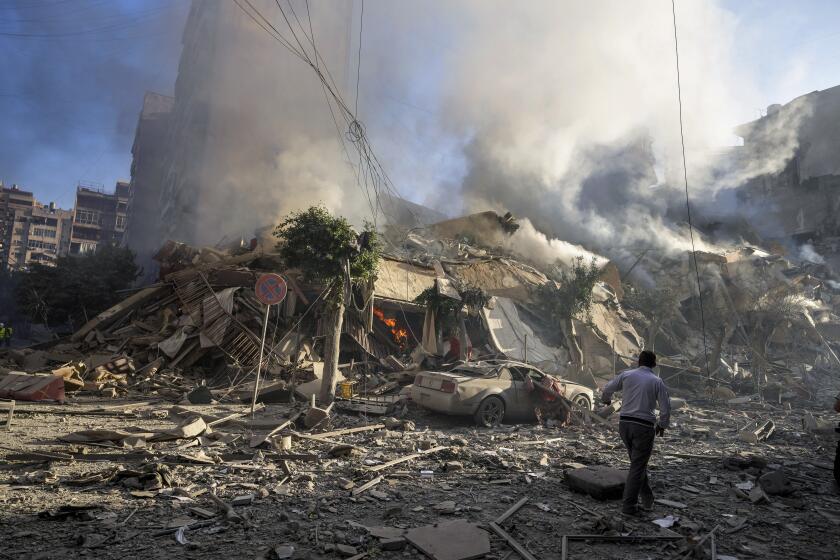Peru’s Nazca culture was brought down with its trees
The Nazca people of Peru -- famous for their huge line drawings on an arid plateau that are fully visible only from the air -- set the stage for their demise by deforesting the plain, allowing a huge El Niño-fueled flood to ravage the Ica Valley about AD 500, researchers have found.
“They died out because they destroyed their natural ecosystem,” said archaeologist Alex J. Chepstow-Lusty of the French Institute of Andean Studies in Lima, coauthor of a paper in the current issue of Latin American Antiquity. “As the population expanded, they put in too many fields and didn’t protect the landscape. The El Niño wiped away society.”
Chepstow-Lusty, David Beresford-Jones of the University of Cambridge and their colleagues used pollen in the soil to trace the horticultural history of the valley, revealing environmental depredation.
The Ica Valley, about 120 miles south of Lima, is barren today but was once a riverine oasis -- a fertile landscape capable of supporting many people. The key to that fertility was a tree called the huarango, or algarrobo.
A member of the Prosopis family, the huarango is a massive, slow-growing relative of mesquite that can live for more than 1,000 years and has roots as deep as 180 feet. The trees have dense wood ideal for construction and fuel, and they trap water from morning mists that waft in from the Pacific.
The pods can be ground into flour or used to produce beer. Seed and pod fragments are common in coprolites, fossilized human feces.
In large part because of the huarango, the Nazca flourished from the time of Christ to about AD 500. They are renowned not just for their geoglyphs -- the giant drawings, whose purpose remains a mystery -- but for their pottery and textiles.
Yet little is known about them. Most of their artifacts, kept in museums around the world, were looted, so they were never seen in archaeological context.
“There has been a lot of theorizing and not much data,” Beresford-Jones said.
Middens -- garbage dumps -- that date to about 200 B.C. contain the remains of mollusks and fish from the ocean, about 15 miles away. (The early Nazca were largely fishermen.) Preserved pollen is virtually only from huarango trees and weeds, Chepstow-Lusty said.
Coinciding with the early rise of the civilization, however, cotton pollen began to appear and huarango pollen began to decline, the research team found.
Then about AD 400, the Nazca apparently stopped growing cotton and began producing large quantities of maize, squash beans and other foods. Huarango pollen dropped off sharply, indicating that the Nazca had cut down most of the trees, probably to use the wood or to clear land for agriculture.
About AD 500, a major El Niño built up in the Pacific, deluging the nearby Andes with rain. Walls of water and mud washed down the valley and over the denuded landscape, sweeping away food crops, buildings and artifacts.
Beresford-Jones compared it with the 1997-98 El Niño, which left the city of Ica 6 feet underwater and “washed a late-intermediate archaeological site out to sea.” That event “looks like a relatively modest affair” compared with the one that destroyed the Nazca, he said.
After AD 500 or so, only pollen from plants adapted to salty and arid conditions can be found, Chepstow-Lusty said.
The region is now “completely empty of any vegetation whatsoever,” Beresford-Jones said.
“It’s a deflated landscape: The wind has blown away the topsoil, so that features such as canals that were once cut into the landscape are now standing up above it, preserved in hard calcite.”
Dunes have built up on the windward side of the canals, preserving the soil underneath and providing good sites for excavation. The team has even found footprints preserved for 1,500 years.
After the flood, other researchers have shown, the Nazca civilization fragmented and fought. Infant mortality rose; life expectancy fell.
Eventually, the Wari people came down from the nearby mountains and conquered the remnants of the Nazca, incorporating them into Wari society.
Chepstow-Lusty says modern Peru can learn from the research. The exploitation of oil, gas and gold resources is leading to widespread deforestation along rivers, which will reduce the region’s already fragile water supply, he said. The last few huarango groves on the southern coast are being cleared for illegal charcoal production.
“Peru should be thinking about restoring those ecosystems on a massive scale if it is going to survive,” Chepstow-Lusty said. Because the capital is perched in the middle of a desert, “Lima is in a very fragile situation.”
More to Read
Sign up for Essential California
The most important California stories and recommendations in your inbox every morning.
You may occasionally receive promotional content from the Los Angeles Times.










